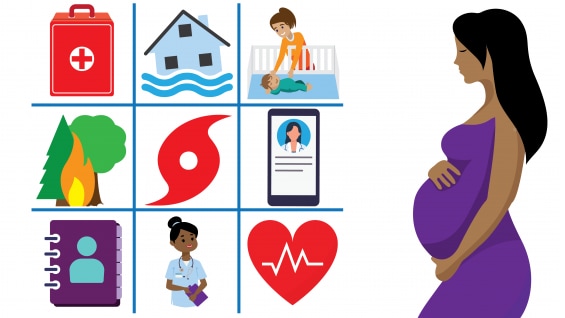At a glance
These tools and resources can assist public health professionals and emergency planners when preparing for and responding to the needs of women of reproductive age, caregivers, and infants before, during, and after public health emergencies. Many of these were developed collaboratively with local, state, and federal partners.

Tools and Resources
Emergency Planning and Response Tools
This toolkit outlines basic planning steps, highlights key resources and promising practices, and explains critical data and information to be integrated into emergency planning for MCH populations. It was developed with federal MCH experts and partners.
Public Health Emergency Preparedness and Response Checklist for Maternal and Infant Health
This checklist, developed by the Association of Maternal and Child Health Programs (AMCHP) in collaboration with DRH, serves as a framework for local, state, tribal, and territorial emergency planning around the needs of women of reproductive age, especially pregnant and postpartum people, and infants.
Reproductive Health and Disasters (RHAD) Assessment Toolkit 2.0
This toolkit, developed by the Council of State and Territorial Epidemiologists (CSTE) in collaboration with DRH, can be used by agencies or communities to assess the reproductive health needs of women ages 15-44, pregnant and postpartum people, and infants less than 1 year old affected by disasters.
Infant and Young Child Feeding in Emergencies (IYCF-E) Toolkit
This toolkit can be used by states, communities, programs, and emergency preparedness and response personnel to best support families and provide optimal nutrition to infants and young children during emergencies.
MCH Epidemiology and Emergency Preparedness and Response Capacity Assessment
This capacity assessment, developed by the Council of State and Territorial Epidemiologists (CSTE) in collaboration with DRH, describes the current state of MCH emergency preparedness and response within state and territorial public health departments. This project was an opportunity to expand on existing assessments and develop new content, with a focus on overall capacity for MCH preparedness and response at an organizational and individual level.
Health Indicators for Disaster-Affected Pregnant Women
This guide includes common epidemiologic indicators for pregnant and postpartum people and infants who are affected by disasters and offers suggested measurement approaches.
This online self-paced 2-part training course, developed by the Association of Maternal and Child Health Programs (AMCHP) in collaboration with DRH, provides strategies for including the unique needs of women of reproductive age, specifically pregnant and postpartum people, and infants in emergency preparedness and response efforts.
Pregnant Population Size Estimator
Pregnant Population Size Estimator
This tool estimates the number of people who are pregnant in a jurisdiction in the United States at any given point in time. The tool can be used for preparedness and response efforts.
This tool can be used to estimate the number of people who are pregnant in a geographic area using Excel software.
Communication Resources
Disaster Safety for Expectant and New Parents Feature
This website lists tips and safety messages to help keep expectant and new parents safe before, during, and after a disaster.
Sample Scripts for Counseling Families on Disaster Preparedness and Infant Safe Sleep
This document outlines ways to counsel parents and caregivers about steps they can take before and during a disaster to provide a safe sleep environment for their baby.
Zika Contraception Access Network (Z-CAN) Tools
Zika Contraception Access Network (Z-CAN) Program
This website describes the Zika Contraception Access Network (Z-CAN) program developed by the CDC Foundation, in partnership with CDC, and established a network of trained physicians across Puerto Rico that provided client-centered contraceptive counseling and same-day access to the full range of FDA-approved reversible contraceptive methods at no cost during the 2016–2017 Zika virus outbreak.
This toolkit provides “how to” information for organizations that are interested in learning about, replicating, or adapting key components of The Zika Contraception Access Network (Z-CAN) program.
Pregnancy Risk Assessment Monitoring System (PRAMS) Emergency Response and Preparedness Questions
Standard and supplemental questions are available on the PRAMS questionnaire to help jurisdictional health departments understand the effects of emerging infections and major natural disasters on maternal and infant health. Pretested questions on emergency preparedness can be found on page 30 of this topic list.
